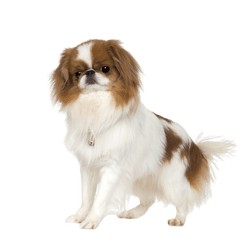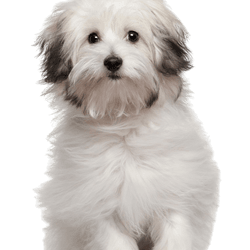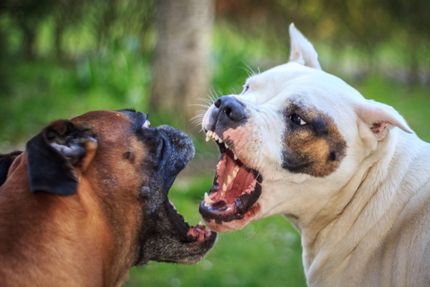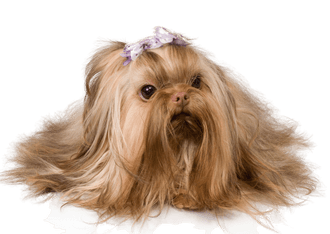
Bolonka Zwetna Breed description: Character & Co
Bolonka Zwetna
Facts & Origin
What is the origin of Bolonka Zwetna?
It is assumed that the ancestor of the Bolonka Zwetna was the Bolonka Franzusaka with white fur coat, which already served as a lapdog for the French and Russian nobility during the Renaissance. It is said that even the famous Empress of Russia Catherine the Great was a lover of these small animals. During her time as a ruler of the Tsar's court Romanov, she was accompanied by small dogs. It is also known from doubtful sources that King Ludwig IV is said to have once presented one of the white four-legged creatures as a gift to a Russian Tsar. Other suppositions suggest that Napoleon's army brought the ancestors of the Bolonka Zwetna to Russia. After the Second World War, the population of the Bolonka Franzuska had shrunk considerably, so breeders began to crossbreed with other small breeds such as the Lhasa Apso, the Bolognese, the Shut Tzu and the Pekinese. In 1966 the first breeding standards were recognised in Russia, but the Bolonka Zwetna is not registered as a breed of its own right with the international dog association FCI.
What are the breed characteristics of Bolonka Zwetna?
The name Bolonka Zwetna comes from Russian and means as much as "colourful lap dog". This is exactly what your four-legged friend likes to do best: cuddling with its humans. They are very affectionate and needy of love. The slightly elongated physique is typical for the breed. Because of their slightly raised ears, the head looks bigger than it actually is. Very typical are the whiskers and chin beard, which decorates their face. The big eyes make them look very cute. The teeth also catch your attention: Mos of the time Bolonka Zwetna have a scissor bite.




| Alternate Name | Tsvetnaya Bolonka, Russkaya Tsvetnaya Bolonka, Russian Tsvetnaya Bolonka |
| Origin | Russia |
| Life expectancy | 10 - 15 years |
| Care requirements | high-maintenance |
| Activity level | average |
| FCI group | not recognised |
| AKC group | Foundation Stock Service |
| KC group | not recognised |
Attitude, character and temperament of the breed
What are typical characteristics of Bolonka Zwetna?
A Bolonka Zwetna is very attached to its owner and fixates on the people that care for it. If you want to buy a Bolonka Zwetna, it would be ideal if you could take them to work with you. It does not like to stay home alone. This should hardly be a problem, as the lovable Bolonka Zwetna is sure to take the hearts of your colleagues by storm. They don't need much space and will adapt to your way of life easily: They'll be as comfortable in a city apartment as in the countryside, as long as they can be with you. Since it neither tends to yap nor is aggressive, it is the perfect companion for all situations. Even if you already have other pets like a cat, the Bolonka Zwetna will integrate well. A typical feature of the breed is also the tail, which the animal carries over its back.
Character
Usage
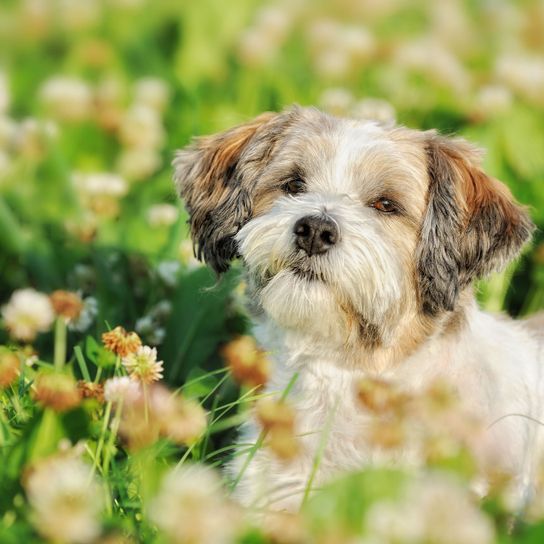


Health and breeding information
What are typical diseases of the Bolonka Zwetna?
Even if your Bolonka Zwetna begs you with their cute little eyes, you shouldn't give them too many treats. The small and light dog does not need much food. Every kilogram too much has a negative effect. In the past, the following genetic diseases have been observed in the breed:
- Hip joint dysplasia
- Progressive retina atrophy
- Patella Luxation
- cataracts.
In addition, the Bolonka Zwetna has a tendency to develop tartar: it is therefore worth checking their small teeth regularly and cleaning them gently if necessary.
What should you consider in regards to Bolonka Zwetna breeding?
Bolonka Zwetna puppies from a reputable breeder are free of hereditary diseases and will be handed over to their new owners in a healthy state. Because of the tendency of developing eye diseases, you should take a close look at the parent animals during your first visit to the breeder.


Appearance and coat of the Bolonka Zwetna
The small dog has a dense and long coat, which covers their body in waves or curls. If you suffer from dogs shedding a lot of hair, a Bolonka Zwetna is just the right pet for you: Because this breed does not lose any hair, despite its thick coat. Nevertheless, regular grooming is necessary. On the one hand, the little animal enjoys every stroke and usually keeps still while you brush it extensively. On the other hand, you prevent tangles and remove the dead hairs that get stuck in their coat. Another peculiarity of the Bolonka Zwetna is noticeable: The older they get, the lighter their coat becomes. As the Russian word for colourful "zwetna" suggests, the Bolonka Zwetna breeder has animals in different colours. Only uni-coloured and spotted are not tolerated according to the breed standard. It is also stipulated that the white content should not be more than 20 percent.
How big does a Bolonka Zwetna get?
The Bolonka Zwetna grows to a height of 20 to 36 centimetres.
How much does a Bolonka Zwetna weigh?
The animals reach a weight between two and five kilograms.
What is the average age of a Bolonka Zwetna?
This little dog can reach an age of about 15 years. Small dog breeds tend to grow older than larger breeds or giant breeds.
| Fur length | medium |
| Fur | curly |
| Ear shape | Floppy Ear |
| Tail | short |
| Anatomy | rugged |
| Size ♀ | 22 - 26 cm |
| Weight ♀ | 3 - 4 kg |
| Size ♂ | 24 - 26 cm |
| Weight ♂ | 3 - 4 kg |
| Suitable For | Children |
Colors




FAQ
-
No, the Bolonka Zwetna is not a yapper and is considered an ideal, calm and sensitive comrade in the family and for children.
-
A Bolonka Zwetna puppy is very expensive and can cost 3000 euros. There are crossbreeds and animals from animal welfare, which are significantly cheaper. In addition, you can give a dog a second chance at a "FOR-IMMER-HOME".
-
On average, a Bolonka dog should be out for about 2 hours a day. However, due to his active nature, he will not complain if it is more.
Other small dogs
Useful Articles
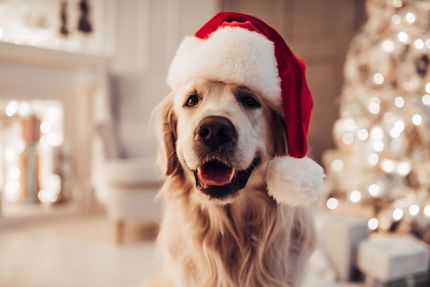
You can find articles that might interest you in the dogbible blog to match your favorite breed.
Visit our magazineto stay up to date on dog trends.
To find out more, view our Privacy Policy
Find here the breed that suits you and find out what character traits it has. Here you can also learn more about the origin, size and weight of your favorite breeds.
Matching your favorite breed, you'll find articles that might interest you on the dogbible dog blog.
5 tips for a city trip with a dog - how to make it work so that everyone gets something out of it!
Annual check-up at the vet: you and your dog should be prepared for this
Beef Pizzles as Bully Sticks for the dog
KONG for the dog - the allround toy
Should Dogs Be Allowed On The Couch? - yes or no and how to break the habit




